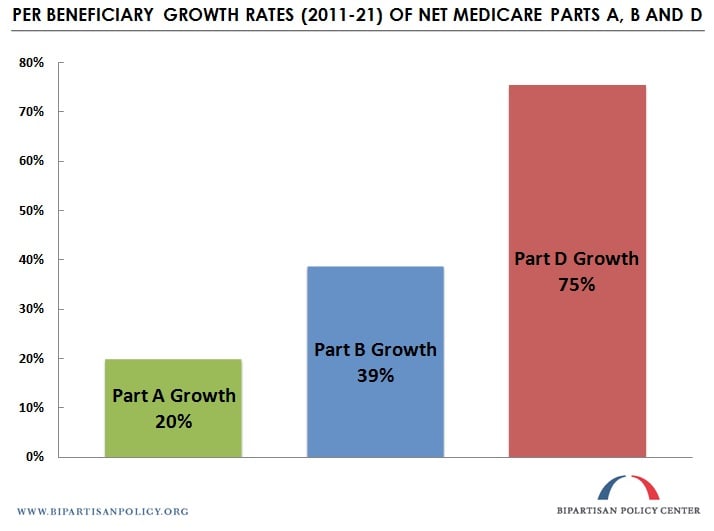Don’t Forget About Part D
Jonathan Goldstein contributed to this post.
The principal driver of future federal deficits is the rapidly mounting cost of Medicare. Most of the discussions about reining in the program’s spending, however, have focused on Parts A and B, whereas the prescription drug benefit (Part D) largely has been ignored.* Yet, Part D costs per beneficiary are projected to grow almost twice as much as Part B’s and almost four times as much as Part A’s over the next ten years. Part D alone will cost taxpayers just under a trillion dollars over that same period.
These numbers may be surprising?particularly considering that Part D costs thus far have come in below original projections?but they ought to be in every legislator’s mind as deficit reduction proposals are developed and enacted. Given budgetary realities, the second-class treatment of Part D in cost-containment discussions seems ill-advised.

Souce: The Congressional Budget Office Note: Estimates assume that Medicare physician payments are maintained at 2011 levels

Souce: The Congressional Budget Office Note: Estimates assume that Medicare physician payments are maintained at 2011 levels
The BPC’s Debt Reduction Task Force proposal would leverage Medicare’s buying power to increase rebates from pharmaceutical companies. Under the current Part D system, private insurers, who provide Part D coverage, are tasked with negotiating rebates from manufacturers for non-generic drugs, usually in return for more favorable coverage. Medicaid, in contrast, has instituted a minimum rebate level on the average manufacturer price in its coverage of prescription drugs. By utilizing the purchasing power of the government to require a minimum rebate ? in a similar vein to Medicaid ? Congress can achieve savings for the program and help bend the cost curve. This is one important piece of the Part D reform puzzle. Of course, that policy alone will not be sufficient. Many others have been circulated by various thought leaders and they deserve serious consideration by lawmakers.
There can be no lasting solution to the U.S. debt crisis without structural changes in the Medicare program to slow its cost growth. And it’s hard to slow Medicare’s cost growth without addressing the fastest growing piece.
* Standard Medicare coverage consists of three components: 1) Hospital insurance (often referred to as “Part A”), 2) Acute and post-acute care (“Part B”), and 3) Prescription drug coverage (“Part D”). Part A covers inpatient care in hospitals, hospice, skilled nursing facilities, and home health care. Part B applies to medically necessary services and supplies (such as doctor services), outpatient care and other medical services. Part D pays for prescription drug coverage provided by private insurers. Related Posts
- Coburn/Lieberman Propose Bipartisan Fix to Medicare, July 8, 2011
Share
Read Next
Support Research Like This
With your support, BPC can continue to fund important research like this by combining the best ideas from both parties to promote health, security, and opportunity for all Americans.
Give Now